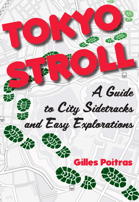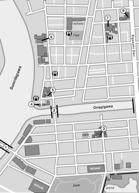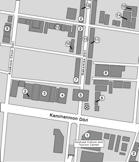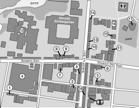











Tokyo Stroll Supplement: Zōshigaya Station Area

This page is for locations in the Zōshigaya Station Area of Tokyo. This neighborhood is not part of my book Tokyo Stroll.
For information on Tokyo Stroll and this web supplement see Tokyo Stroll Supplement home page
For users of the Organic Maps, Maps.Me and Google Maps apps the items below have bookmarks you can import into those apps to make navigation easier.
Instructions and links are on the Viewing Locations in Organic Maps, Maps.Me, Google Maps, or Google Earth page.
Some entries on this page may include a note that says "Description to be added soon ." These entries are for items I felt should be listed even if the description is not ready to assist those who wish to plan a trip. When possible I included a link to an official web page, I suggest also doing web searchs for more information.
Located just south of Ikebukuro, this neighborhood is also in Toshima-ku.
Like Ikebukuro you will see owls motifs in Zōshigaya.
I have also created a web page on the Zōshigaya Shichifukujin Meguri / Zōshigaya Seven Lucky Gods Pilgrimage route that spans both the Ikebukuro Station Area and the Zōshigaya Station Area.
Akamaru Bakery (赤丸ベーカリー)
A local bakery that has been in operation by the same family since the 1920s. The custard filled cream bun and Akamaru Rusk are two of the most popular items, they also have pudding, curry-pan, a variety of sandwiches, and much more. A small seating area is to one side in the bakery.
NEAREST TRAIN/SUBWAY STATIONS: Kishibojimmae Station (Toden Arakawa Line), Zoshigaya Station (Tokyo Metro Fukutoshin Line)
CLOSED: Thursdays and 1st & 3rd Wednesdays.
TWITTER: https://twitter.com/akamarup
Chitose Bridge (千登世橋)
Built in 1932 this bridge is a well known landmark that spans Meiji Dōri Avenue at the intersection with Mejiro Dōri, the Toden Arakawa Line also passes under the bridge. The steel bridge is painted green and has art deco lanterns at each end. There are metal railings on either side of the pedestrian walkways.
NEAREST TRAIN/SUBWAY STATIONS: Kishibojimmae Station (Toden Arakawa Line), Zoshigaya Station (Tokyo Metro Fukutoshin Line)
Iseya Shokuryōhinten (いせや食料品店)
Before there were convenience stores there were small shops like this one that sold a range of items households would commonly need. Iseya Shokuryōhinten has a selection with a focus on groceries, candy, toys, and freshly cooked food. Originally this was a simmered bean shop and it still sells a variety of such items. The store is in a very well maintained pre-war building.
NEAREST TRAIN/SUBWAY STATIONS: Kishibojimmae Station (Toden Arakawa Line), Zoshigaya Station (Tokyo Metro Fukutoshin Line)
Kamikawaguchiya (上川口屋)
An old fashioned cheap sweet shop called a dagashiya, these not often seen these days. Kamikawaguchiya was founded in 1781 and is located on the grounds of Zōshigaya Kishimojindō. Kamikawaguchiya is still operated by the same family and is the oldest dagashiya in Tokyo. The building was built in the late 19th century and survived the fires of the 1923 Great Kantō Earthquake and the fire bombings of WWII. This is a great place to stop by for candies old fashioned or modern. However be aware that the selection of wonderful unpackaged items made by the shop is large enough that you may find yourself having to ponder your decision for some time before making it. The sweet shop in the Studio Ghibli movie Only Yesterday is said to be modeled after Kamikawaguchiya.
NEAREST TRAIN/SUBWAY STATIONS: Kishibojimmae Station (Toden Arakawa Line), Zoshigaya Station (Tokyo Metro Fukutoshin Line)
Kiazuma Coffee (キアズマ珈琲)
On Kishimojin Omotesandō you will find a two story neighborhood coffee shop that uses the old sock-filtered technique to make a cup of coffee. They serve coffee from many parts of the world and will have a recommended "coffee of the day." Also on the menu are tea, and cake. Some English is spoken and they have an English menu. To find it look for a small red sign with the name in Japanese. It is also next door to the Zōshigaya Information Center. The doors are glazed sliding ones.
NEAREST TRAIN/SUBWAY STATIONS: Kishibojimmae Station (Toden Arakawa Line), Zoshigaya Station (Tokyo Metro Fukutoshin Line)
NOTE: Non-smoking, wheel chair accessible.
CLOSED: Wednesdays.
FACEBOOK: https://www.facebook.com/kiazuma/
INSTAGRAM: https://www.instagram.com/kiazumacoffee/
Kishimojin Omotesandō (鬼子母神表参道)
Not far from Kishibojinmae Station on the Toden Arakawa Line, or Zōshigaya Station on the Tokyo Metro Fukutoshin Line, is a narrow road, Kishimojin Omotesandō, approaching the Kishimojindō temple going straight north which is lined with keyaki (zelkova) trees some of which are hundreds of years old. the road is 100 meters (328 feet) long. The land the trees are on was donated to the Kishimojindō by Nagashima Takumi in the Tenshō Era (1573-1592). In 1940 the lane was declared a Natural Monument of Tokyo. The trees are cared for and replaced by the government and the Avenue of Zelkova Trees at Kishimojin Daimon Preservation Society.
NEAREST TRAIN/SUBWAY STATIONS: Kishibojimmae Station (Toden Arakawa Line), Zoshigaya Station (Tokyo Metro Fukutoshin Line)
Mitakesan Seiryūin (清立院)
Originally this was a Shingon temple called Seiryūji founded in the Kanki Era (1229-1232) the name was change to Seiryuin when the temple affiliated with the Nichiren sect around 1675. Behind the temple is an eleven headed kannon statue with nearby stone depicting the area in the Edo Period. The temple was considered a place to pray for relief from skin diseases and the Edo Meisho Zue notes that farmers would pray for rain here. One of the trees on the grounds is called the "Rain Prayer Pine."
NEAREST TRAIN/SUBWAY STATIONS: Kishibojimmae Station (Toden Arakawa Line), Zoshigaya Station (Tokyo Metro Fukutoshin Line)
PILGRIMAGE: This temple is on the Zōshigaya Shichifukujin Meguri route for Bishamonten. The statue of Bishamonten is a designated cultural property of Toshima Ward. Place your stamp on the center-left of the shikishi.
WEB: http://seiryuin.or.jp/en/
Namiki House (並木ハウス)
An eleven room two story apartment building built in 1953 just off of Kishimojin Omotesandō, access is via a walkway next to Kiazuma Coffee. The most famous tenant in this building was Tezuka Osamu who moved into an apartment in 1954 and lived there for three years. Another famous tenant who resided there around the same time when he was a student at Waseda University was architectural photographer Futagawa Yukio. Next to it is the Namiki House Annex which was built in 1932. Both buildings were restored in 2009 to maintain their look and to bring them more in line with the building codes. While much of the neighborhood was bombed in WWII the part that Namiki House is in did not burn preserving some of the older buildings in the area. One interesting detail is that the building owner had a model airplane factory before Namiki House was built. Namiki House and the Namiki House Annex were registered as a national tangible cultural property in 2018.
NEAREST TRAIN/SUBWAY STATIONS: Kishibojimmae Station (Toden Arakawa Line), Zoshigaya Station (Tokyo Metro Fukutoshin Line)
NOTE: Do not enter, this is an apartment building so respect the privacy of the occupants.
WEB: https://namikihouse.com/en/
Niku no Ōkubo (肉の大久保)
A neighborhood butcher shop with a reputation for a variety of tasty take out foods. These include ham katsu and croquettes.
NEAREST TRAIN/SUBWAY STATIONS: Kishibojimmae Station (Toden Arakawa Line), Zoshigaya Station (Tokyo Metro Fukutoshin Line)
Seido Kishimojindō (清土鬼子母神堂)
Another Nichiren temple to Kishimojin, this small temple is at the location where the statue of Kishimojin enshrined at Zōshigaya Kishimojindō was excavated here in 1561. This temple also has an unusual triangular well where it is said the statue was purified.
PILGRIMAGE: This is also a Zōshigaya Shichifukujin Meguri site as there is a statue of Kisshōten, who is also called Kichijōten. She is sometimes listed as one of the seven lucky gods in place of either Jurōjin or Fukurokuju. The red stamp on your shikishi goes at the middle right.
NEAREST TRAIN/SUBWAY STATION: Gokokuji Station (Tokyo Metro Yūrakuchō Line)
NOTES:
The temple is in a residential area with the entrance to the south.
This temple is actually in northern Bunkyō-ku.
Toden'arakawa-sen / Toden Arakawa Line aka Tokyo Sakura Tram (都電荒川線 東京さくらトラム)
The only streetcar line in the 23 ku area of Tokyo, the only other tram line, the Tokyu Setagaya Line, runs outside the 23 ku area. The line runs from Minowabashi Station in Arakawa-ku to Waseda Station in Shinjuku-ku. The Toden system opened in 1913 and this line survived the closure of the other lines between 1967 and 1972 due to trams slowing down the increasing road traffic that resulted from many families owning autos by then. A combination of opposition by residents to closing the line, the fact that very little of it runs on roadways, and that there were no good routes for buses to replace it enabled the line to continue operating. In 2017 the line was officially given the nickname of the Tokyo Sakura Tram. Riding the line gives you an interesting view of Tokyo with fellow passengers consisting of a cross section of the populace. The line is 12 km long with 30 stops, a full trip takes 56 minutes. You enter at the front and exit at the rear, it is possible to buy either a ticket for a single ride or a day pass. There are enough interesting sites along the route that getting a day pass and exploring what is near several stations is worth it. The trains are very regular, during rush hour every 3–6 minutes, otherwise every 6–7 minutes.
NEAREST TRAIN/SUBWAY STATIONS:
Higashi-ikebukuro-yonchome Station, Kishibojimmae Station, Mukōhara Station, Toden-zoshigaya Station.
Zōshigaya Cemetery / Zōshigaya Reien (雑司ケ谷霊園)
One of the largest and most famous cemeteries in the Tokyo area. Zōshigaya Cemetery was founded in 1874. Many famous persons are buried here including Koizumi Yakumo (Lafcadio Hearn), Ogino Ginko (the first licensed women physician in Japan, her grave has a statue of her), Nakahama "John" Manjirō, Nagai Kafū, Hani Motoko (founder of the magazine Fujin no Tomo "The Women’s Friend"), Takehisa Yumeji, Izumi Kyōka, Tōjō Hideki, and Natsume Sōseki. Maps showing where the graves are is available at the office, also many of the more famous graves have a small green name plate with the person's name in Roman letters. The cemetery also has restrooms.
NEAREST TRAIN/SUBWAY STATIONS: Higashi-ikebukuro Station (Tokyo Metro Yūrakuchō Line), Higashi-ikebukuro-yonchome Station (Toden Arakawa Line), Kishibojimmae Station (Toden Arakawa Line), Toden-zoshigaya Station (Toden Arakawa Line), Zoshigaya Station (Tokyo Metro Fukutoshin Line)
WEB: https://www.tokyo-park.or.jp/reien/park/index071.html#googtrans(en)
Zōshigaya Information Center / Zōshigaya an'nai sho (雑司が谷 案内処)
This center is on Kishimojin Omotesandō leading up to Zōshigaya Kishimojindō and next door to Kiazuma Coffee. Here is where you can find maps and tourist information. They also sell fancier shikishi for the Zōshigaya Shichifukujin Meguri.
NEAREST TRAIN/SUBWAY STATIONS: Kishibojimmae Station (Toden Arakawa Line), Zoshigaya Station (Tokyo Metro Fukutoshin Line)
The second floor has a gallery space for exhibits.
WEB: http://www.toshima-mirai.jp/zoshigaya/
Zōshigaya Kishimojindō (雑司ヶ谷鬼子母神堂)
A Nichiren sect Buddhist temple which houses a statue of Kishimojin who is associated with easy childbirth, protects children, and in Pure Land Buddhism is considered a generally protective Bodhisattvā. Presently this temple is a branch temple for the nearby Ikōsan Hōmyōji in Minami Ikebukuro. The origin tale of the temple tells of farmers finding a buried statue and building a hut to protect it. The current honden, main hall, was built in 1664 with funds donated by Princess Man the wife of Asano Mitsuakira the daimyō of Hiroshima-han which accounts of some Aki region architectural details. There were 58 carpenters who worked on the building and the chief carpenter was Tanaka Shōdayū Munetomo. The building with its attractive carvings and survived the bombings of WWII, in 1960 it was declared a Tangible Cultural Property of Tokyo and was later designated a National Important Cultural Property in 2016. The temple underwent extensive restoration from 1976 to 1979 to restore it to the look it had in the Edo Period. To the left of the hall is a huge ginkgo tree planted in the Ōei Era (1394-1427) by Sojo Nichiryu, In the Edo Period there was a belief that women who hugged the tree would have children. The tree was designated a National Natural Monument (second class) in 1930, this designation was canceled in 1956 and later that year the tree was designated as a Natural Monument of Tokyo. There is a stone monument in front of the tree with “Natural Monument, Ginkgo of Kishimojin” inscribed on it. The tree was also designated a Toshima City Important Trees for Landscape in 2017. The grounds also include an Inari shrine where Uka no mitama no mikoto is enshrined which predates Zōshigaya Kishibojindō.
The temple is known for selling susuki mimizuku, small owl figures made from susuki grass that originated here when a local girl started making and selling them to buy medicine for her mother. However if you are traveling from overseas and buy one be sure to have agricultural inspectors at customs inspect the owl when you return as it may harbor foreign pests.
NEAREST TRAIN/SUBWAY STATIONS: Kishibojimmae Station (Toden Arakawa Line), Zoshigaya Station (Tokyo Metro Fukutoshin Line)
PILGRIMAGE: This temple is also on the Zōshigaya Shichifukujin Meguri route as Daikoku is also enshrined at this temple. The description of where the ink pad and stamp for your shikishi is that I found states "a small hut on the right as you enter the temple grounds." However it does not say which entrance. I assume it is the one on the north east not far from the Kishimojin Omotesandō. The upper right-hand corner is where you stamp the shikishi. A Japanese tradition says that Daikokuten is the husband of Kishimojin.
EVENTS:
Temple fairs every month on the 8th, 18th, and 28th.
On October 16th - 18th the large Oeshiki to commemorate the death of Nichiren is held.
WEB: https://www.kishimojin.jp
Zōshigaya kyū Senkyōshikan / Zōshigaya Old Missionary Museum (雑司が谷旧宣教師館(旧マッケーレブ邸))
The western style home of John Moody McCaleb a Churches of Christ missionary from Tennessee who moved to Japan with his wife Della in 1892 and lived in the foreigner enclave in Tsukiji until he had this house built in 1907 in the Carpenter Gothic style. Here he established a school, founded a journal, and had a large vegetable garden to supply his kitchen. Some elderly locals have memories of time spent with him. McCaleb lived here until his return to the US in 1941 and the house eventually was purchased by Toshima-ku in 1982. It was declared a tangible cultural property by Toshima-ku in 1987 and again by the Tokyo government in 1999. In 1989 it opened to the public as a museum.
NEAREST TRAIN/SUBWAY STATIONS: Kishibojimmae Station (Toden Arakawa Line), Zoshigaya Station (Tokyo Metro Fukutoshin Line)
CLOSED: Mondays, Tuesday if Monday is a holiday, Sunday of the 3rd week and the Year-End and New Year.
MUSEUM PAMPHLET: https://mitte-x-img.istsw.jp/kanko-toshima/file/Guide/en/ZMM_en.pdf
WEB: https://www.city.toshima.lg.jp/129/bunka/bunka/shiryokan/kyusenkyoshikan/004412.html
Zōshigaya Ōtori Jinja (雑司が谷 大鳥神社)
This shrine dates from 1712 when it was set up to protect against pox and is considered the guardian shrine of Zōshigaya. Before the area was urbanized this shrine was popular with farmers who prayed here for good crops. Zōshigaya was famous for its eggplants and the shrine grows them in pots on the grounds. Something else you will see at the shrine is the motif of money bags on various decorations, even the donation box is shaped like one.
NEAREST TRAIN/SUBWAY STATIONS: Kishibojimmae Station (Toden Arakawa Line), Zoshigaya Station (Tokyo Metro Fukutoshin Line), Toden-zoshigaya Station (Toden Arakawa Line)
PILGRIMAGE: This shrine is the Zōshigaya Shichifukujin Meguri shrine for Ebisu and a good place to buy a shikishi for the pilgrimage. Ebisu is associated with commerce and the statue of him here has hin seated on a money bag. The stamp for the shikishi here is next to the temizuya where you purify yourself. Place the stamp on the upper left corner of the shikishi.
ACCESS: Close to, and between, Toden-Zōshigaya Station on the Toden Arakawa Line or Zōshigaya Station on the Tokyo Metro Fukutoshin Line.
FESTIVALS: Tori no Ichi in November.
WEB: https://shinto-shrine-ootorijinja.business.site/
Back to the Tokyo Stroll Supplement home page - Privacy Notice - Back to Gilles' home page
Created March 14, 2023 | Content last updated July 28, 2025